How Many Positions In Baseball
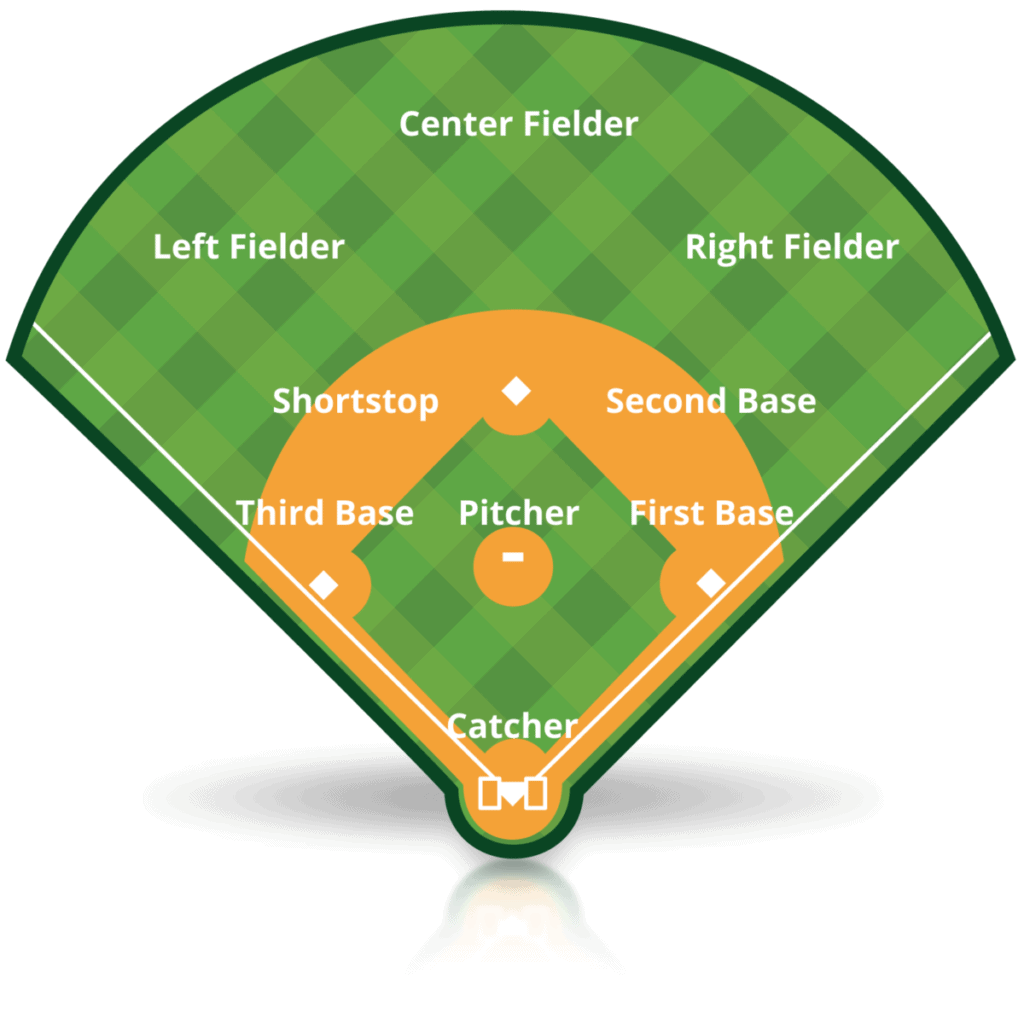
For those new to baseball, understanding all of the different positions and responsibilities can be quite daunting. Then I wanted to put together a complete list of every baseball game position and their roles so those who are learning about baseball tin easily understand what those positions are and what they are responsible for.
In short, there are nine core positions on every baseball team:
- 1 – Pitcher
- 2 – Catcher
- three – First Baseman
- 4 – Second Baseman
- v – 3rd Baseman
- 6 – Shortstop
- vii – Left Fielder
- 8 – Center Fielder
- 9 – Right Fielder
Some baseball game games will also count a 10th position, which is known every bit the designated hitter. This player only has offensive duties, which will be covered later on in this commodity.
Besides, the positions listed above are the exact same numbers scorekeepers apply to score baseball games. And so let'south dive into the details about each baseball position and their roles.
1. Pitcher
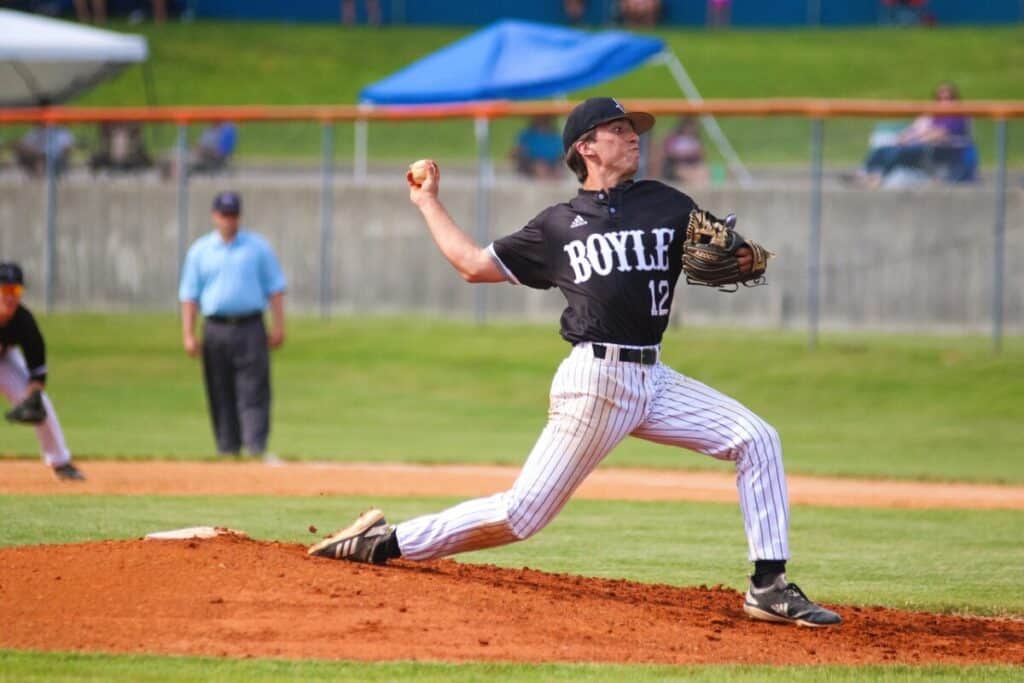
Pitchers have their position on the pitching mound, which is located in the center of the infield. Here, the pitcher begins every individual play by pitching the ball to the catcher, who is behind home plate.
Pitchers seek to get batters out; in other words, they work to prevent hitters from reaching base.
There are a lot of ways for the defense to get an out, but a few common ways to record an out would exist:
- If the batter hits the ball and the ball is either caught in the air past a defensive player before it hits the ground
- By a defensive player throwing the ball to a base of operations earlier the batter gets to the base (strength out)
- By a strikeout, which means the hitter recorded iii strikes in their at-bat
Before every pitch, the pitcher must comply with a couple of rules. First, at least one foot must be touching the safe on the superlative of the pitching mound. And second, their windup, which is the body mechanics earlier throwing the brawl, must besides follow other guidelines to foreclose a balk from being called.
Smashing pitchers tin non only throw the brawl within the strike zone only also at specific locations according to each opponent's weaknesses. The strike zone refers to the space above the dwelling plate, of the same broad as this 1 and a superlative that goes from above the concoction'south knees to below the armpits.
What'south more than, pitchers add other factors to their game to make it more difficult for batters to hit the ball. For example, pitchers learn to throw the ball in different ways with the goal of getting the batter to swing and miss.
The most popular pitch types include:
- 4-seam fastball
- 2-seam fastball
- Curveball
- Slider
- Change-up
Aristocracy pitchers accept these 5 in their pitching repertoire. However, these are not the just pitch types in baseball game. Other known pitch types include the sinker, knuckleball, cutter, and the rare eephus pitch.
Expanding the pitching repertoire allows pitchers to deceive the concoction more easily, as they can vary the movement and speed of his throws. Likewise, a wide pitch repertoire reduces a batter'due south chances of guessing the pitch and thus, hit the ball.
Right-handed vs. Left-handed pitchers
Both correct-handed and left-handed pitchers can play at the highest baseball level. Both have won awards in MLB as Pitcher of the Year, also known every bit the "Cy Young award." All the same, left-handed pitchers have a natural advantage that makes their throws a flake more hard to hitting for batters.
First, batters have a difficult time dealing with the perception and movement of left-handed pitchers. Most pitchers are right-handed so most batters are used to facing a right-handed bullpen.
Another advantage of left-handed pitchers is preventing stolen bases. Pitchers must watch and hold runners on from the stretch and they commonly practise this with runners on the start base.
Right-handed pitchers have no other mode to hold a runner on first base besides showing their back to the runner. If the pitcher wants to check the runner on first base of operations, they'd demand to pivot their whole torso to throw the ball, giving runners time to safely return to the base.
Instead, left-handed pitchers are naturally facing the first base of operations. This state of affairs makes it difficult for runners to lead off too far away from the base of operations, every bit they could be easily caught stealing in their attempt. Consequently, when a left-handed pitcher is on the mound runners don't accept as big of a lead, and then they would accept to cover a larger distance if they were to effort to steal 2d base of operations.
Roles of the Pitcher
Pitchers can be classified as starting pitchers and relief pitchers and the responsibilities of each function depends heavily on the situation of the game.
Starting Pitcher Responsibilities
Starting pitchers throw from the offset inning until the managing director decides to bring a relief pitcher. Although some pitchers are able to last the whole game, it is very common for a relief pitcher to come in for the starting pitcher at some point towards the middle function of the game.
Sometimes, pitchers throw the entire game without giving up a hit, walk, or any runs. That feat is known as a perfect game and is a coveted stat by many starting pitchers.
Commonly, starters are pitchers with remarkable control over the strike zone and have learned to throw a variety of pitch types. When they get tired, their throws get slower and less accurate, which usually allows batters to striking the ball with ease.
Relief Bullpen Responsibilities
A relief pitcher may come in at whatsoever signal later on the game has started and a lot of teams apply multiple relief pitchers in a unmarried game. Commonly, relief pitchers take lower stamina than starters and they typically rely on virtually three pitch types.
We can likewise break down the responsibilities of a relief bullpen into four more sub-categories:
- Long relief: a pitcher with higher stamina than typical relief pitchers. They enter the game when the starter can't make it through the starting time few innings.
- Centre relief: used before the last two innings of the game. Commonly, these pitchers will non pitch more three innings.
- Setup: this is the pitcher in charge of maintaining the team'south reward during the 2nd-to-concluding inning. If they succeed, they are awarded a stat that is called a "hold".
- Closer: the bullpen who tries to get the final three outs and close the game for the win. In the Major Leagues, these pitchers must come into the game with their team upwardly by no more than three runs in order to be awarded a stat chosen a "save". When pitchers successfully shut a game, they are awarded a saved game.
Famous Pitchers
- Randy Johnson
- Mariano Rivera
- Greg Maddux
- Roger Clemens
- Cy Immature
2. Catcher

For many, the catcher is the near demanding position in baseball and is oft referred to equally the hardest position to play in baseball. A catcher's position is behind home plate and information technology is the only player who sees the entire field with the same perspective as batters.
Catchers are the players with the nearly roles in a game of baseball. They not simply contribute to the offensive and defensive aspects just also have to be leaders on the field.
In the defensive role, the catcher's principal job is to receive the throws from the bullpen. To receive throws from the pitcher they practise that while being in a depression squat backside home plate in order for the pitcher to deliver the ball through the strike zone.
Information technology'south of import to catch every pitch because otherwise, the ball will get past the catcher and let base runners to advance. Also, in very competitive leagues, umpires will not call a strike unless the catcher actually catches the brawl.
A catcher must as well throw out whatever base runners that effort to steal a base. This is done by quickly catching and throwing the baseball to the base the runner wants to steal. Sounds elementary enough, but any catcher will tell you that it takes a lot of practice to become expert at quickly catching and throwing the ball to a base.
The skillful news for catchers is that on offense, catchers don't tend to be the star batters of a team. So catchers who excel at hitting add more value to a squad than other catchers. Usually, catchers are in the lower role of the lineup, even though they do have enough power to striking dwelling house runs.
Another gene that separates good catchers from elite catchers is intelligence. The number 2 position on the team demands to be a leader on the field and, on some teams, is even considered as a type of bus by their teammates.
An important responsibility for virtually catchers is to call the pitches the bullpen will make, which means they are also responsible for keeping the opponents scoreless. Catchers signal to the pitcher what pitch to throw and its location. Other catchers, notwithstanding, just receive the calls from the manager.
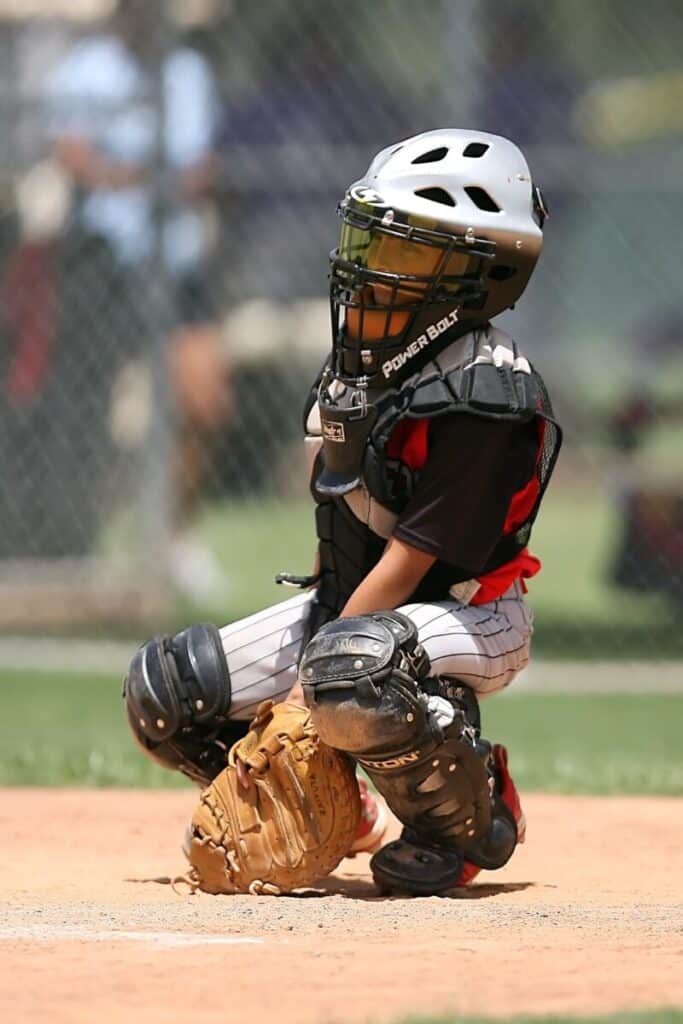
The catcher should also have a good relationship with their pitcher and so they know when to phone call time and briefly encounter with the bullpen to requite their bullpen some time to cool downwardly or to strategize for the next batter.
Being right-handed is most a requirement to be a catcher, as it allows a quicker release of the ball in case of steal attempts – especially to 3rd base. Left-handed catchers practise exist, but they are extremely rare.
In summary, catchers need to be tough guys to suffer the whole game squatting, accept strong artillery, quick anxiety, and quick easily to prevent runners from advancing bases.
Famous Catchers
- Yadier Molina
- Buster Posey
- Iván Rodriguez
3. First Baseman

The first baseman is the closest player to first base, typically positioned several steps backside the base and a few feet into fair territory. This allows the player to encompass plenty space on the field to field basis balls likewise every bit being close plenty to comprehend first base on a ground ball.
Besides pitchers and catchers, first basemen usually go the most action during a game. Whenever a ball gets hit into play there'due south always a chance another infielder volition throw the brawl to commencement base to get the force out.
The main part of a first baseman is to apace run to first base when a batter hits a ground ball and catch the throw to complete the out. When a commencement baseman catches a ball and gets a force out, the get-go baseman is awarded with a stat chosen a "put out".
First baseman tend to get the well-nigh put outs in a game because a lot of force out plays happen at start base.
Both right-handed and left-handed players can comprehend this position, but left-handed individuals are slightly preferred. Left-handed first baseman tin chop-chop throw to the other bases without turning or pivoting as much a right-handed starting time baseman take to.
Having a left-handed first baseman also represents an important defensive advantage, every bit more than double-plays can exist completed when the first baseman is left-handed. When left-handed offset baseman receive a ground ball, they are already in position to throw to second base to begin the double play.
On the offensive aspect, the majority of offset basemen have the power to regularly connect home runs. They are unremarkably big players with more than strength than speed.
Famous First Basemen
- Lou Gehrig
- Albert Pujols
- Prince Fielder
- Marking McGwire
four. Second Baseman

Also known as one of the center infielders, 2nd basemen take position betwixt the first and second base of operations to embrace the middle-correct of the infield.
When a right-handed hitter is taking an at-bat, the 2nd baseman typically plays closer to the 2d base. When the hitter is left-handed, the second baseman positions themselves right in betwixt first and 2d base of operations. This positioning helps foreclose groundballs from passing through to the outfield.
A second baseman needs to be quick on their feet. After the batter makes contact with the brawl, the second baseman has a few quick seconds to field groundballs. Too, second basemen must be agile players to catch the ball, even in the most difficult of circumstances.
The 2nd baseman is involved in many double-plays (where two runners are retired in the same play. Normally ane runner is out at second base and the other is out on first base of operations). Active players tin quickly run to second to complete the first out and so throw to first in the shortest fourth dimension possible.
Unlike first basemen, the second baseman is nigh ever a right-handed player. Even in Little League, it is extremely rare to see a left-handed second baseman.
The reason for coaches favoring a right-handed 2nd baseman is that the throwing arm is naturally directed to starting time base (because well-nigh runners are retired at starting time base). As a result, a right-handed fielder tin quickly release the brawl without having to rotate the trunk in the process. Every second counts when playing infield.
Considering the player is closer to get-go base of operations than the rest of the infield, it is non imperative for the 2nd baseman to have amazing arm strength. Their main role is to cover a lot of basis, exist as practiced as possible with the glove, and become those easy force outs.
In the offensive aspect, 2nd basemen are known to be patient batters. They try to achieve first base either by receiving a walk or hitting singles. One time they reach commencement or second base of operations, their speed becomes a threat for the opponents because 2d basemen typically run fast enough to steal bases or score with on a base striking.
Famous Second Basemen
- Dustin Pedroia
- Joe Morgan
- Jackie Robinson
- José Altuve
- Craig Biggio
five. Third Baseman

Lots of people, even those brand new to baseball, know this position by it'south nickname – the "hot corner". Playing tertiary base has earned this nickname considering ground balls and line drives often come out of the bat with a lot of power, which demands a very quick reaction from the third baseman.
The positioning of the third basemen is somewhat similar to the first baseman. They stand a few feet behind tertiary base and a few anxiety into fair territory.
Against a right-handed hitter, information technology's recommended to stay closer to the foul line, while against a left-handed, it's recommended to play a few steps towards second base. This is just because it is difficult for left-handed hitters to place a batted ball straight downwards the third baseline.
Third basemen are very consummate athletes. They demand a potent arm to retire runners due to the showtime base existence and so far away. Also, they need quick feet. A third baseman has to be able to run frontward when the batter bunts the ball so they are able to quickly brand that out at first.
Similar to the second baseman and shortstop, right-handed players typically cover the third base. One time they receive the ball, they are in a much meliorate position than a left-hander would be to make a throw to any base.
Offensively, the third baseman tends to be a power hitter and volition bat closer to the top of the order.
Famous Third Basemen
- Mike Schmidt
- Alex Rodriguez
- Chipper Jones
- Ron Santo
- Wade Boggs
6. Shortstop
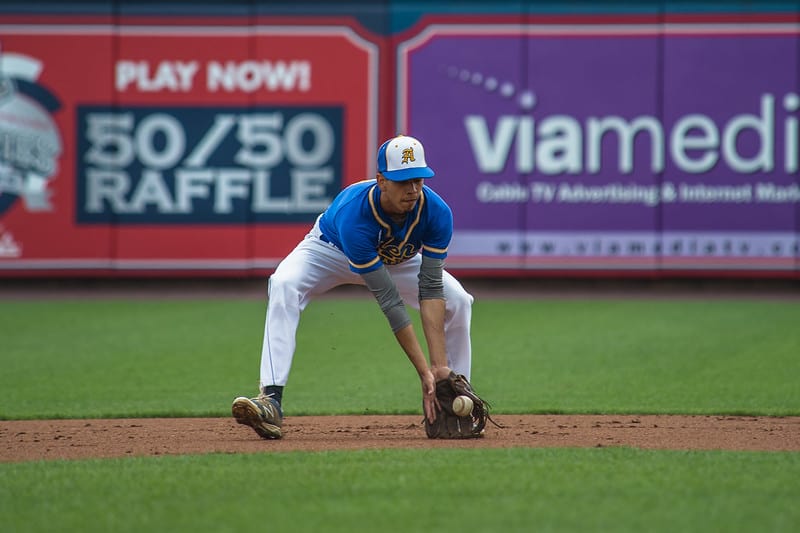
The shortstop is the other centre infielder, along with the second baseman. Shortstops position themselves between second and third base, usually a niggling closer to second base. They are considered the anchor of the infield, thus they are the almost defensively-skilled role player on the team.
The part of a shortstop is to retire batters who hit the ball to the expanse betwixt the second and third baseman. Shortstops are also responsible for being the relay human between the infield and the left-half of the outfield.
A shortstop must exist enlightened of everything happening in the game because many plays require an assist from the shortstop. For example, if a actor attempts to steal 2d base, the shortstop volition either receive the throw or back upward the second baseman. Besides, the shortstop assists the second baseman in double-plays and helps outfielders by being a cut-off man.
Other qualities required in a shortstop are agility and arm strength. Oftentimes, shortstops dive to catch a brawl and so immediately get up and throw to first base of operations. Consequently, they demand a stiff arm and an accuracy throw to retire runners after making a diving play.
Near all shortstops are right-handed because it's easier to take the ball out of the glove and throw to start base of operations and second base without having to pivot their feet equally much as a left-handed actor would need to pivot.
On offense, a shortstop'due south role is to hit singles or doubles and steal bases. Only a few shortstops are both great fielders and neat power hitters.
Did you know shortstops weren't always positioned in between tertiary base and second base of operations? For a brief history of the shortstop position, check out my other article on why shortstop is the sixth position.
Famous Shortstops
- Derek Jeter
- Ozzie Smith
- Omar Vizquel
- Jimmy Rollins
seven. Left Fielder
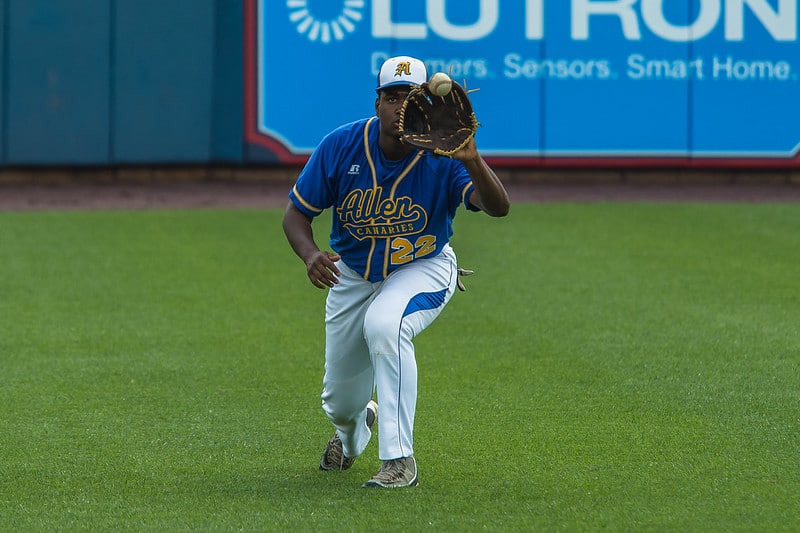
The left fielder is one of the three outfield positions in baseball game along with the center fielder and correct fielder. Specifically, left fielders position themselves in the outfield corner behind 3rd base, into fair territory.
When starting out with baseball a lot of people confuse left field and right field. An easy mode to remember where left field and right field are at is to imagine you're continuing at dwelling house plate and facing the pitcher. The outfield spot that'south to the left is left field while the outfield spot that's to the correct is correct field.
Among the three outfielders, the one in the left typically has the weakest arm. This is past design in case of a throw to tertiary base is needed. Outfielders very rarely make a throw to kickoff base and then left fielders don't need the arm strength to throw it to all the way to first base of operations.
Both right-handed and left-handed players tin play in the left field. Some coaches have a preference for left-handed players in left field because they like the player's glove-side to exist closer to the foul line.
Offensively, left-fielders tin can be either a ability hitter or decent hitters with enough speed to steal bases. If they are ability hitters then they are usually placed in one of the middle spots of the batting guild. Otherwise, they are placed at either end of the lineup.
Famous Left Fielders
- Ted Williams
- Barry Bonds
- Manny Ramirez
- Carl Yastrzemski
- Rickey Henderson
8. Heart Fielder

The middle fielder is the outfielder who has to cover the largest expanse of basis and is typically the fastest player on the team. Their position is in the heart of the outfield (the area behind second base) and they are commonly considered the leader of the outfielders considering they normally have the all-time defensive skills.
Aristocracy center fielders all share some common characteristics. Kickoff of all, they are the fastest fellow member of the team. The center fielder is responsible for communicable balls hitting toward the entire length of the center area of the outfield, plus a good portion of the centre-correct and eye-left outfield.
When the centre fielder and ane or more teammates go for the aforementioned flyball, information technology is the eye fielder who has the priority of communicable the ball. For that reason, center fielders can and should lead the defence force by calling for catchable fly balls and making the catch.
Still, neat speed is not enough for an elite center fielder. Center fielders must also possess a potent throwing arm. The roles of a centre fielder include rapidly returning the ball to the infield to prevent runners from taking an extra base afterwards a striking, and accurately throwing out runners in 2nd, third, or home plate.
It's very common to encounter center fielders be the lead-off batter. Their speed poses a peachy threat early in the game if they get on base of operations. Also, managers might ask left-handed center fielders to bunt in the very first at-bat of the game, every bit these players could accomplish first base by relying on their speed.
Interested in condign a centre fielder? Larn how to play center field in baseball.
Famous Center Fielders
- Joe DiMaggio
- Mike Trout
- Mickey Drape
- Willie Mays
9. Right Fielder
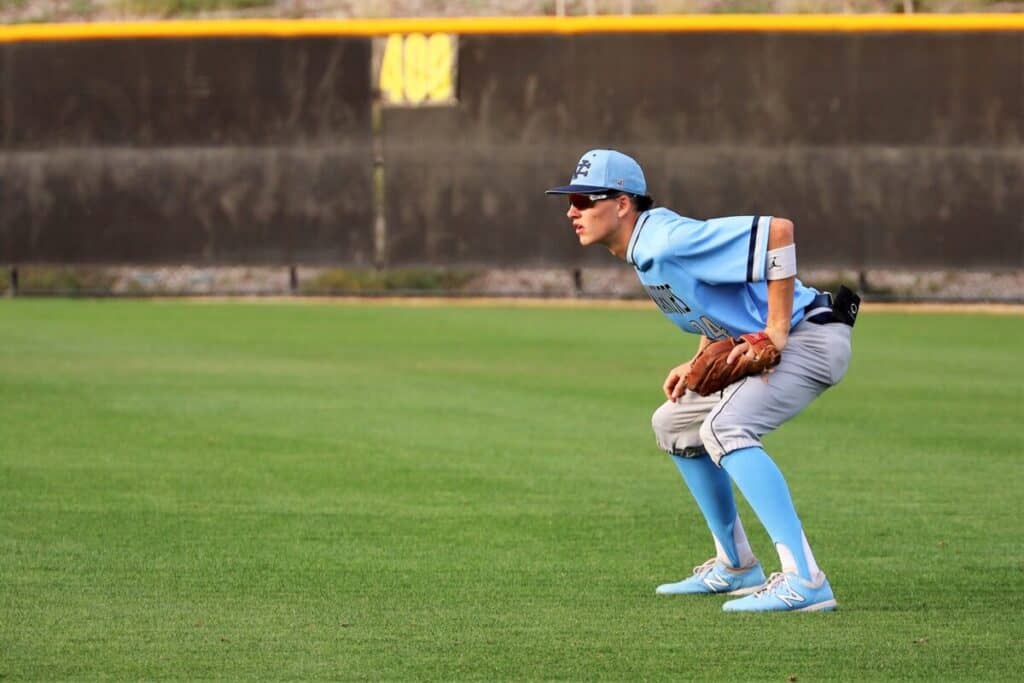
The right fielder is the other corner outfield position. Considering in that location is a prevalence of correct-handed hitters, correct field is where the least number of assurance are striking.
Every bit with the other outfielders, right fielders also need to comprehend a lot of ground, but right fielders also need a strong arm in instance they need to make a throw to tertiary. Additionally, if they can't apace render the ball to the infield, runners can hands turn a single into a double.
Although managers prefer to see right fielders who can cover a lot of ground and have a potent arm, it's also mutual to see managers place power hitters with less mobility in this position. This is because because correct fielders are non strongly involved in the game so they volition not need to use their mobility every bit much as other positions would require.
Equally you'll observe from the famous right fielders' list below, right fielders tend to exist the power hitters of the squad. So a lot of right fielders will bat towards the heart of the club.
Famous Correct Fielders
- Babe Ruth
- Reggie Jackson
- Hank Aaron
- Ichiro Suzuki
10. Designated Hitter (DH)
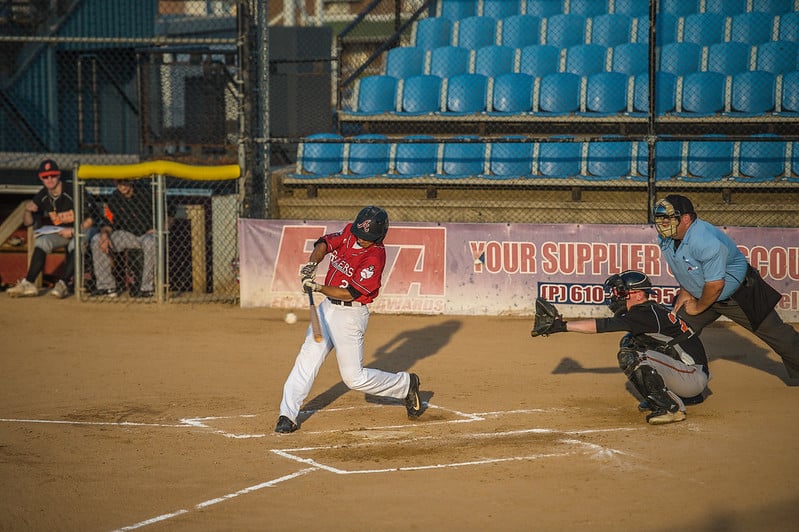
Although it's not a traditional defensive position, the designated hitter is an important position in some baseball leagues. For example, in the MLB at that place are two leagues – the National League and the American League – but the designated hitter just existed in the American League prior to the 2022 season. At the starting time of the 2022 MLB season, the Designated Hitter is allowed in both leagues.
In almost Caribbean leagues, the designated hitter is a common position.
The role of the designated hitter is uncomplicated – hit the ball. Designated hitters have a spot in the batting order, only they don't play defensively. They can be used in identify of any defensive player in the batting order, merely typically designated hitters volition take the at-bat in identify of pitchers, who normally are not very practiced hitters.
A team can besides choose to play without a designated hitter. In that scenario, the pitcher (or whomever the DH would normally bat for) would have an at-bat equally long as they are in the game. If the manager wants to bring a pinch hitter, that player must be removed from the game get-go.
Designated hitters tend to be power hitters and bat in the middle spots of the lineup. It's very common to encounter designated hitters as quaternary batters, which is considered the "make clean-up" spot in the batting social club and is usually occupied by someone who can striking home runs on a abiding basis.
Famous Designated Hitters
- David Ortiz
- Frank Thomas
- Jason Giambi
Decision
Each position in baseball certainly has a mutual player profile and set of responsibilities to follow while on the field. However, each play has its own small variations and each player brings a different ready of skills to their position. It's small things like these that make the game so interesting and exciting.
Baseball has been played for over a century, and the perfect way to strategize around a game hasn't been constitute yet. There are strategies that have worked great in the past, simply non exist relevant as new information is discovered about the current players. And then, information technology's wise to fall-back on the common characteristics of each baseball game position and learn about their roles and responsibilities.
How Many Positions In Baseball,
Source: https://baseballtrainingworld.com/understanding-every-baseball-position-and-their-role/
Posted by: matneyfror1958.blogspot.com


0 Response to "How Many Positions In Baseball"
Post a Comment